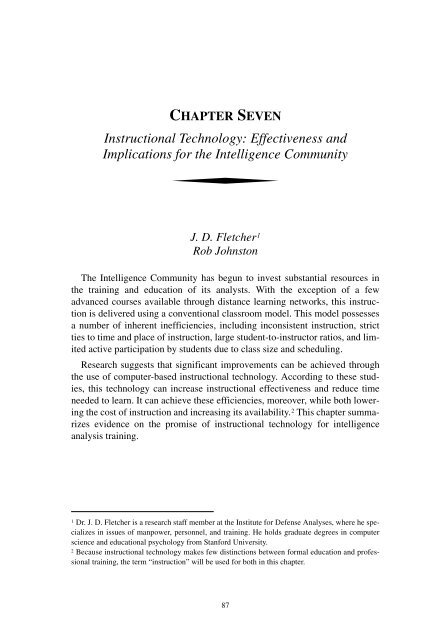Analytic Culture in the U.S. Intelligence Community (PDF) - CIA
Analytic Culture in the U.S. Intelligence Community (PDF) - CIA
Analytic Culture in the U.S. Intelligence Community (PDF) - CIA
Create successful ePaper yourself
Turn your PDF publications into a flip-book with our unique Google optimized e-Paper software.
CHAPTER SEVEN<br />
Instructional Technology: Effectiveness and<br />
Implications for <strong>the</strong> <strong>Intelligence</strong> <strong>Community</strong><br />
J. D. Fletcher 1<br />
Rob Johnston<br />
The <strong>Intelligence</strong> <strong>Community</strong> has begun to <strong>in</strong>vest substantial resources <strong>in</strong><br />
<strong>the</strong> tra<strong>in</strong><strong>in</strong>g and education of its analysts. With <strong>the</strong> exception of a few<br />
advanced courses available through distance learn<strong>in</strong>g networks, this <strong>in</strong>struction<br />
is delivered us<strong>in</strong>g a conventional classroom model. This model possesses<br />
a number of <strong>in</strong>herent <strong>in</strong>efficiencies, <strong>in</strong>clud<strong>in</strong>g <strong>in</strong>consistent <strong>in</strong>struction, strict<br />
ties to time and place of <strong>in</strong>struction, large student-to-<strong>in</strong>structor ratios, and limited<br />
active participation by students due to class size and schedul<strong>in</strong>g.<br />
Research suggests that significant improvements can be achieved through<br />
<strong>the</strong> use of computer-based <strong>in</strong>structional technology. Accord<strong>in</strong>g to <strong>the</strong>se studies,<br />
this technology can <strong>in</strong>crease <strong>in</strong>structional effectiveness and reduce time<br />
needed to learn. It can achieve <strong>the</strong>se efficiencies, moreover, while both lower<strong>in</strong>g<br />
<strong>the</strong> cost of <strong>in</strong>struction and <strong>in</strong>creas<strong>in</strong>g its availability. 2 This chapter summarizes<br />
evidence on <strong>the</strong> promise of <strong>in</strong>structional technology for <strong>in</strong>telligence<br />
analysis tra<strong>in</strong><strong>in</strong>g.<br />
1<br />
Dr. J. D. Fletcher is a research staff member at <strong>the</strong> Institute for Defense Analyses, where he specializes<br />
<strong>in</strong> issues of manpower, personnel, and tra<strong>in</strong><strong>in</strong>g. He holds graduate degrees <strong>in</strong> computer<br />
science and educational psychology from Stanford University.<br />
2<br />
Because <strong>in</strong>structional technology makes few dist<strong>in</strong>ctions between formal education and professional<br />
tra<strong>in</strong><strong>in</strong>g, <strong>the</strong> term “<strong>in</strong>struction” will be used for both <strong>in</strong> this chapter.<br />
87
















